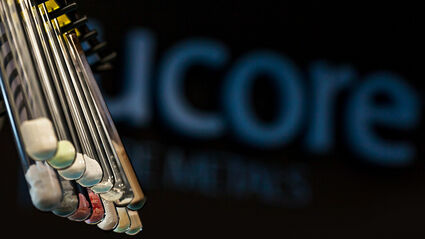Ucore ships Bokan REE sample for testing
Material will test rare earth separation test for Alaska SMC North of 60 Mining News – October 16, 2020
Last updated 10/22/2020 at 8:25pm

Ucore Rare Metals Inc.
Innovation Metals will focus on separating the highest-value rare earth elements – terbium, dysprosium, neodymium, and praseodymium – from the sample of material from Ucore Rare Metals' Bokan Mountain project in Southeast Alaska.
Ucore Rare Metals Inc., which has set a plan in motion to begin producing rare earth elements in Alaska by 2023, has shipped more than 1.5 metric tons of material from its Bokan Mountain project to Innovation Metal Corp.'s RapidSX facility in Ontario for concentration and REE separation testing.
Ucore acquired Innovation Metals earlier this year and is operating the company as a subsidiary to further advance RapidSX technology for the separation and purification of rare earth elements and other critical metals.
It is this process technology that Ucore plans to implement at the Alaska Strategic Metals Complex, a commercial-scale rare earths separation and purification plant to be built at the Southeast Alaska port town of Ketchikan.
Alaska SMC is the first step of Alaska2023, a business plan unveiled by Ucore earlier this month that envisions the start of rare earths production in Alaska in three years. After getting this separation facility churning out rare earth oxides from feedstock supplied by others, the company plans to develop a mine at its Bokan Mountain REE and critical minerals project on Prince of Wales Island, which is only about 30 miles from Ketchikan.
According to a calculation completed in 2019, the Dotson Ridge deposit at Bokan hosts 4.79 million metric tons of indicated resource averaging 0.6% (31,722 metric tons) rare earth oxides, 460 parts per million (2,205 metric tons) niobium; 1,880 ppm (9,001 metric tons) zirconium; 48 ppm (231 metric tons) beryllium; 37 ppm (178 metric tons) hafnium; 0.37% (17,715 metric tons) titanium dioxide; and 97 ppm (464 metric tons) vanadium.
In addition, Dotson Ridge hosts 1.05 metric tons of inferred resource averaging 0.6% (6,979 metric tons) total rare earth oxides; 470 ppm (493 metric tons) niobium; 1,897 ppm (1,992 metric tons) zirconium; 46 ppm (48 metric tons) beryllium; 35 ppm (37 metric tons) hafnium; 0.44% (4,652 metric tons) titanium dioxide; and 112 ppm (118 metric tons) vanadium.
Though the overall grade of the rare earths found at Bokan is not particularly high, roughly 40% of the REEs fall in the heavy category, which tend to be in higher demand and more expensive. When you add in the other metals, all of which are deemed critical, this project shows the potential to be a vital domestic source of many of these mined commodities for which the U.S. is currently import-reliant.
While delivering Bokan Mountain rare earths and critical minerals into the American supply chain is Ucore's ultimate objective, the more immediate goal is to get the Alaska SMC producing REEs from feedstock for other U.S. and allied sources.
"Ucore is developing our heavy REO (rare earth oxide) production facility in Alaska because we believe the need for Bokan to go into production is inevitable. Alaska will be a vital hub for sourcing and subsequent production," said Ucore Rare Metals COO Mike Schrider. "In the shorter term, Alaska will be a critical hub for the processing of 'pre-Bokan' feedstocks, because that is what is needed now. And when we require additional secure, domestic HREE (heavy rare earth elements) supply, Bokan will be ready to deliver."
To make sure both the RapidSX and Bokan Mountain are ready to deliver, Ucore sent a bulk sample to Ontario for processing.
Innovation Metals will focus on separating the highest-value rare earths from the Bokan feed – terbium, dysprosium, neodymium, and praseodymium. These four rare earths are critical to various high-power REE magnets that improve the efficiencies and capabilities of modern technologies such as electric vehicle motors, wind turbine generators, MRI scanners, and computer hard drives.

Ucore Rare Metals Inc.
A float plane lands on the bay in front of Bokan Mountain, a Southeast Alaska mine project that hosts rare earths, niobium, zirconium, beryllium, hafnium, titanium, and vanadium. Further details of Ucore's Alaska2023 business plan and RapidSX can be read by clicking on the photo.
"We are very excited to have IMC initiate the production of high-purity REOs from concentrates that will be produced from our Bokan HREE-rich feed material with the RapidSX technology," said Schrider.
Ucore estimates it will cost roughly US$35 million to build the Alaska SMC with RapidSX technology and the company is pushing to move ahead with the facility as quickly as possible.
"The Alaska2023 timelines are aggressive and necessary to ensure US participation in a variety of emerging high-tech industries such as information technology, communication and electric vehicles," said Ucore Rare Metals CEO Pat Ryan.
Further details of Ucore's Alaska2023 business plan and RapidSX can be read at Ucore unveils Alaska2023 rare earths plan in the Oct. 7 edition of Metal Tech News. Click on the float plane photo for a link to the article.















Reader Comments(0)